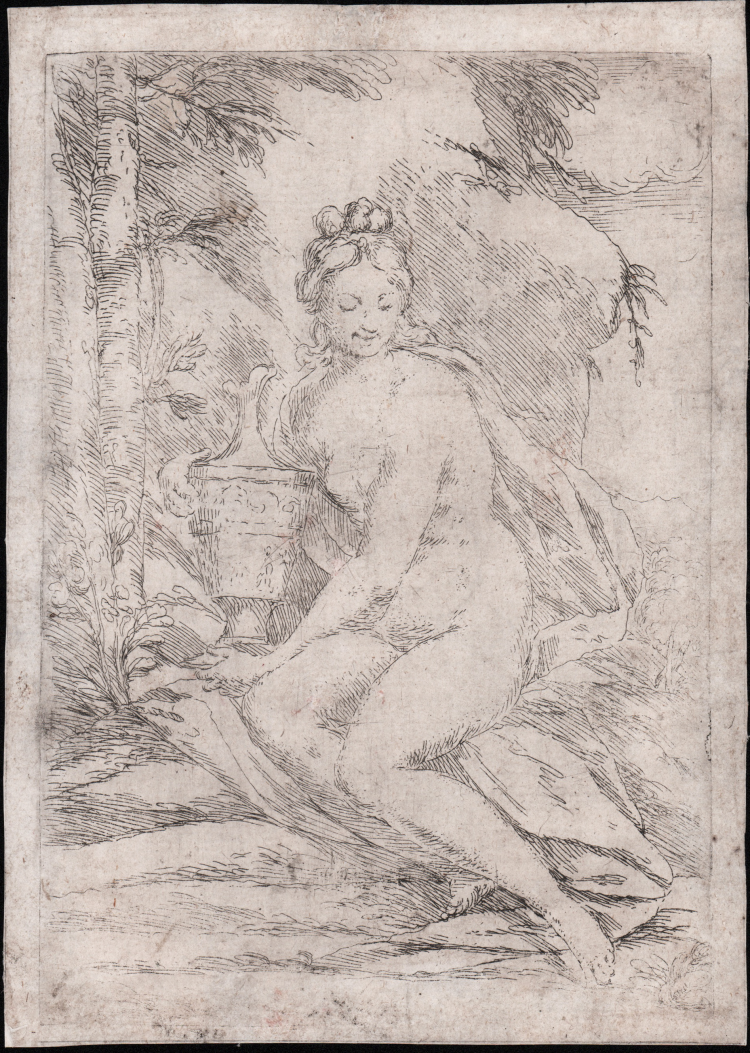




| Reference: | S42017 |
| Author | Giuseppe DIAMANTINI |
| Year: | 1663 ca. |
| Measures: | 145 x 208 mm |



| Reference: | S42017 |
| Author | Giuseppe DIAMANTINI |
| Year: | 1663 ca. |
| Measures: | 145 x 208 mm |
Etching, ante 1663, unlettered.
In all the impressions examined, a vertical lone, due to plate damage, goes from the woman’s left arm to her right leg. The etching may date from the end of the artist’s activity when his works began to anticipate elements of eighteenth-century style.
According to Luca Baroni the plate is from the series of Pleiades, consisting of seven seven plates; they constitute a compact whole in terms of style, technique, format and subject. They probably correspond (with the addition of a further unidentified specimen or perhaps coinciding with S.R5) to the "eight allegorical figures" described by Heinecken (1778-1790, IV, p. 651) and then passed on in subsequent literature (Huber 1797-1804, IV, nn. 34-31, p. 80; Gori Gandellini, De Angelis 1811, IX, nn. 24-31, p. 144; Vernarecci 1892, n. 22. p. 87).
The series, of allegorical and decorative inspiration, reveals considerable virtuosity and freedom of execution. The simplifications of the drawing and chiaroscuro, the lack of signatures or printing initials and a general neo-sixteenth-century taste (which seems to look, as already suggested by the critics, to the world of Marcantonio Raimondi and, we might add, to certain themes developed by Agostino Carracci) suggest an early date, before 1663.
The subject of the group can be tentatively recognized in the Pleiades, figures of classical mythology originating in Arcadia, daughters of Atlas and Peione and corresponding to the seven stars of the homonymous constellation. According to tradition, one of the Pleiades (alternately identified with Sterope, Elettra or Merope) would be less visible than the others, because of the shame caused by its past behavior. In the series engraved by Diamantini, in fact, one of the figures (S.1b) is turned of back and seems to want to hide to the look of the observer. It should be noted, however, that this subject would constitute an iconographic unicum in seventeenth-century Venice, with the exception of the canvas, dubiously identified with Orion and the Pleiades, painted by Pietro Liberi for Palazzo Ferro Fini in Venice (Ruggeri 1996, no. P69, p. 144).
A good impression, on contempoprary laid paper, with margins, good condition.
Bibliografia
TIB 4730.016; Le Blanc, I, p. 123, n. 29; L. Baroni, in Giuseppe Diamantini pittore e incisore dalle Marche a Venezia (2021), pp. 270 – 271.
Giuseppe DIAMANTINI (Fossombrone 1621 - 1705)
|
Diamantini was educated in Bologna at first, where he was deeply influenced by the imitators of Carraccio. He also studied the changes of Classicism and the innovations coming from the painters in Rome and Venice, especially though his friendship with Simone Cantarini.
Around 1650 he moved to Venice where he developed his artistic language in close contact with Pietro Liberi e Sebastiano Mazzoni.
The most important contact he had in this period was that with Carpioni from whom he took up his sentimental classicism, a smooth picturesqueness and the tendency to leave the figures not perfectly defined.
He was a very conventional and modest painter, but his drawings and engravings were excellent; his graphic catalogue of etchings contains 40 pieces, according to Bartsch, the majority of which depict mythological scenes.
|
Giuseppe DIAMANTINI (Fossombrone 1621 - 1705)
|
Diamantini was educated in Bologna at first, where he was deeply influenced by the imitators of Carraccio. He also studied the changes of Classicism and the innovations coming from the painters in Rome and Venice, especially though his friendship with Simone Cantarini.
Around 1650 he moved to Venice where he developed his artistic language in close contact with Pietro Liberi e Sebastiano Mazzoni.
The most important contact he had in this period was that with Carpioni from whom he took up his sentimental classicism, a smooth picturesqueness and the tendency to leave the figures not perfectly defined.
He was a very conventional and modest painter, but his drawings and engravings were excellent; his graphic catalogue of etchings contains 40 pieces, according to Bartsch, the majority of which depict mythological scenes.
|